Full Text Searchable PDF User Manual
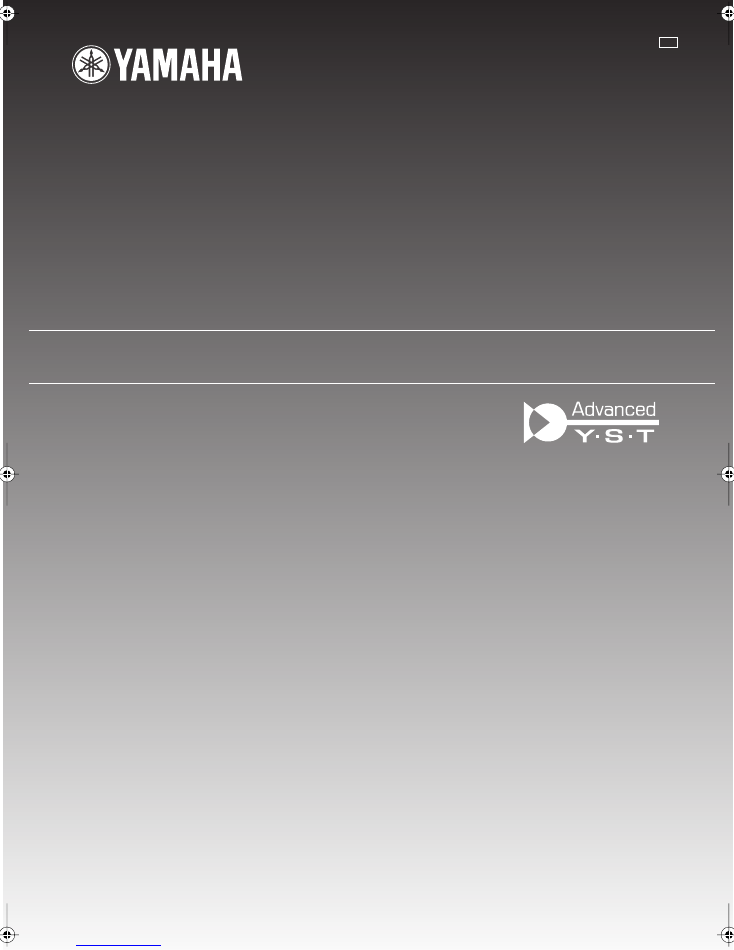
i
NS-P240
NS-P246
(NS-P240/NS-P246: NX-S120 + NX-C120 + SW-P240)
NS-P240
HOME CINEMA 5.1CH SPEAKER SYSTEM
NS-P246
HOME CINEMA 6.1CH SPEAKER SYSTEM
OWNER’S MANUAL
NS-P240
NS-P246
(NS-P240 / NS-P246: NX-S120 + NX-C120 + SW-P240)
HOME CINEMA 5.1CH SPEAKER PACKAGE
HOME CINEMA 6.1CH SPEAKER PACKAGE
OWNER’S MANUAL
U
NSP240,246̲U.book Page i Wednesday, October 22, 2003 3:29 PM
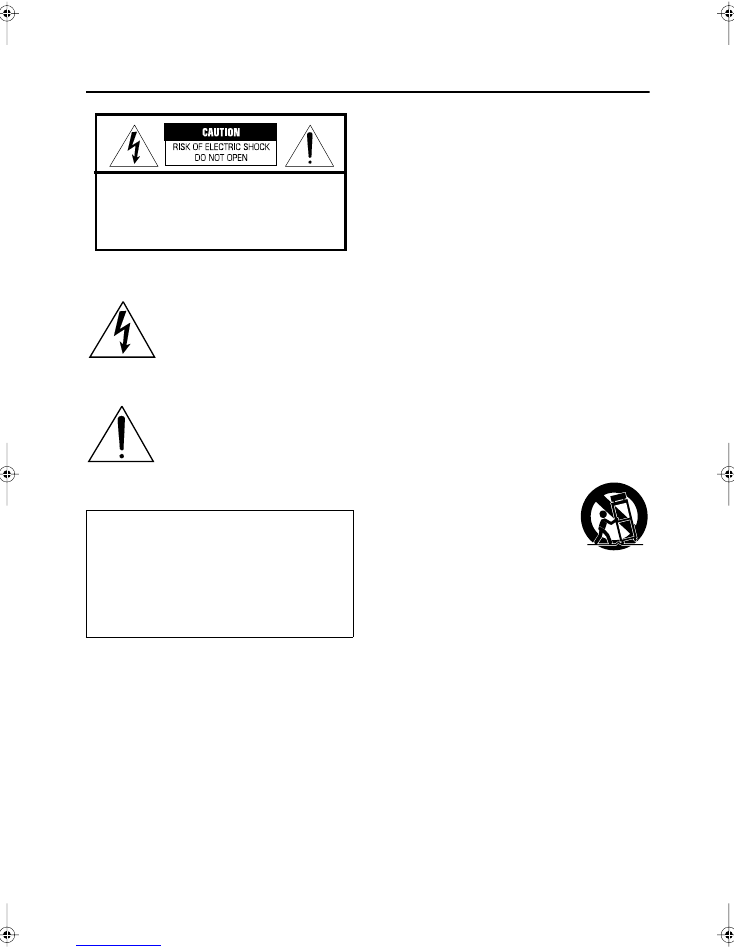
i
IMPORTANT SAFETY INSTRUCTIONS
•
Explanation of graphic symbols:
The lightning flash with arrowhead
symbol within an equilateral triangle is
intended to alert you to the presence of
uninsulated “dangerous voltage” within
the product’s enclosure that may be of
sufficient magnitude to constitute a risk
of electric shock to persons.
The exclamation point within an
equilateral triangle is intended to alert
you to the presence of important
operating and maintenance (servicing)
instructions in the literature
accompanying the appliance.
1
Read these instructions.
2
Retain these instructions.
3
Heed all warnings.
4
Follow all instructions.
5
Do not use this apparatus near water.
6
Clean only with a dry cloth.
7
Do not block ventilation openings. Install in
accordance with the manufacturer’s instructions.
8
Do not install near heat sources such as radiators,
heat registers, stoves, or other heat-producing
apparatus (including amplifiers).
9
Do not defeat the safety purpose of the polarized or
grounding-type plug. A polarized plug has two
blades, one wider than the other. A grounding type
plug has two blades and a third grounding prong. The
wide blade or the third prong are provided for your
safety. If the provided plug does not fit into your
outlet, consult an electrician to replace the obsolete
outlet.
10
Protect the power cord from being walked on or
pinched, particularly at plugs, convenience
receptacles, or the point at which the power cord
exits the apparatus.
11
Use only attachments/accessories specified by the
manufacturer.
12
Use only with a cart, stand, tripod,
bracket, or table specified by the
manufacturer, or sold with the
apparatus. When a cart is used, use
caution when moving the cart/
apparatus combination to avoid
injury from tip-over.
13
Unplug this apparatus during lightning storms or
when unused for long periods of time.
14
Refer all servicing to qualified service personnel.
Servicing is required when the apparatus has been
damaged in any way, such as if the power supply
cord or plug is damaged, liquid has been spilled or
objects have fallen into the apparatus, the apparatus
has been exposed to rain or moisture, does not
operate normally, or has been dropped.
15
Be sure to allow a space of at least 20 cm above,
behind and on both sides of SW-P240.
16
Do not place the following objects on SW-P240:
A vessel containing liquid.
If the vessel falls due to vibration and the liquid spills,
the unit may be damaged, and/or you may receive an
electric shock.
IMPORTANT
Please record the serial number of this system in the
space below.
Model:
Serial No.:
The serial number is located on the rear of the unit.
Retain this Owner’s Manual in a safe place for future
reference.
CAUTION: TO REDUCE THE RISK OF
ELECTRIC SHOCK, DO NOT REMOVE COVER
(OR BACK). NO USER-SERVICEABLE PARTS
INSIDE. REFER SERVICING TO QUALIFIED
SERVICE PERSONNEL.
NSP240,246̲U.book Page i Wednesday, October 22, 2003 3:29 PM
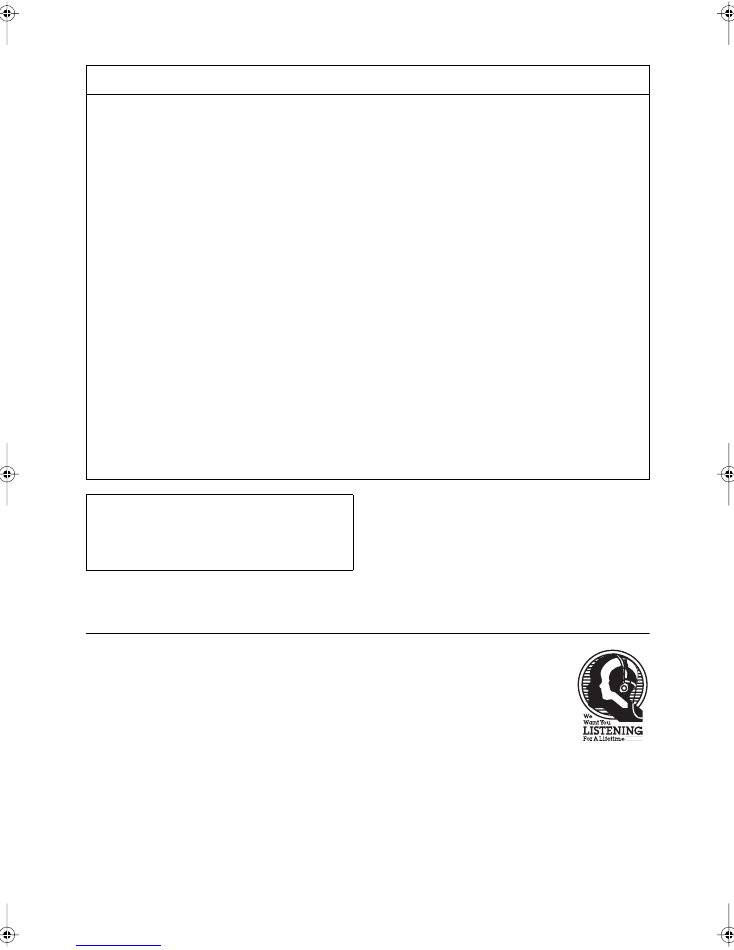
ii
We Want You Listening for a Lifetime
Yamaha and the Electronic Industries Association’s Con-
sumer Electronics Group want you to get the most enjoy-
ment out of your equipment by playing it at a safe level
— a level that lets the sound come through loud and
clear without annoying blaring or distortion — and, most
importantly, without damaging your sensitive hearing.
Since hearing damage from loud
sounds is often undetectable until it is
too late, Yamaha and the Electronic
Industries Association’s Consumer
Electronics Group recommend that
you avoid prolonged exposure to
excessive volume levels.
FCC INFORMATION (for US customers)
1. IMPORTANT NOTICE: DO NOT MODIFY THIS
UNIT!
This product, when installed as indicated in the
instructions contained in this manual, meets FCC
requirements. Modifications not expressly
approved by Yamaha may void your authority,
granted by the FCC, to use the product.
2. IMPORTANT:
When connecting this product to
accessories and/or another product, use only high
quality shielded cables. Cable(s) supplied with this
product MUST be used. Follow all installation
instructions. Failure to follow instructions could void
your FCC authorization to use this product in the
USA.
3. NOTE:
This product has been tested and found to
comply with the requirements listed in FCC
Regulations, Part 15 for Class “B” digital devices.
Compliance with these requirements provides a
reasonable level of assurance that your use of this
product in a residential environment will not result
in harmful interference with other electronic
devices.
This equipment generates or uses radio
frequencies and, if not installed and used in
accordance with the instructions in the user’s
manual, may cause interference harmful to the
operation of other electronic devices.
Compliance with FCC regulations does not guarantee
that interference will not occur in all installations. If this
product is found to be the source of interference, which
can be determined by turning the unit “OFF” and “ON,”
please try to eliminate the problem using one of the
following measures:
• Relocate either this product or the device that is being
affected by the interference.
• Utilize power outlets that are on different branch
circuits (circuit breaker or fuse) or install AC line
filter(s).
• In the case of radio or TV interference, relocate or
reorient the antenna. If the antenna lead-in is 300 ohm
ribbon lead, change the lead-in to a coaxial type cable.
If these corrective measures do not produce satisfactory
results, please contact the local retailer authorized to
distribute this product. If you cannot locate the
appropriate retailer, please contact Yamaha Electronics
Corp., U.S.A.; 6660 Orangethorpe Ave; Buena Park, CA
90620.
The above statements apply ONLY to those products
distributed by Yamaha Corporation of America or its
subsidiaries.
For Canadian Customers
To prevent electric shock, match wide blade of plug to
wide slot and fully insert.
This Class B digital apparatus complies with Canadian
ICES-003.
NSP240,246̲U.book Page ii Wednesday, October 22, 2003 3:29 PM
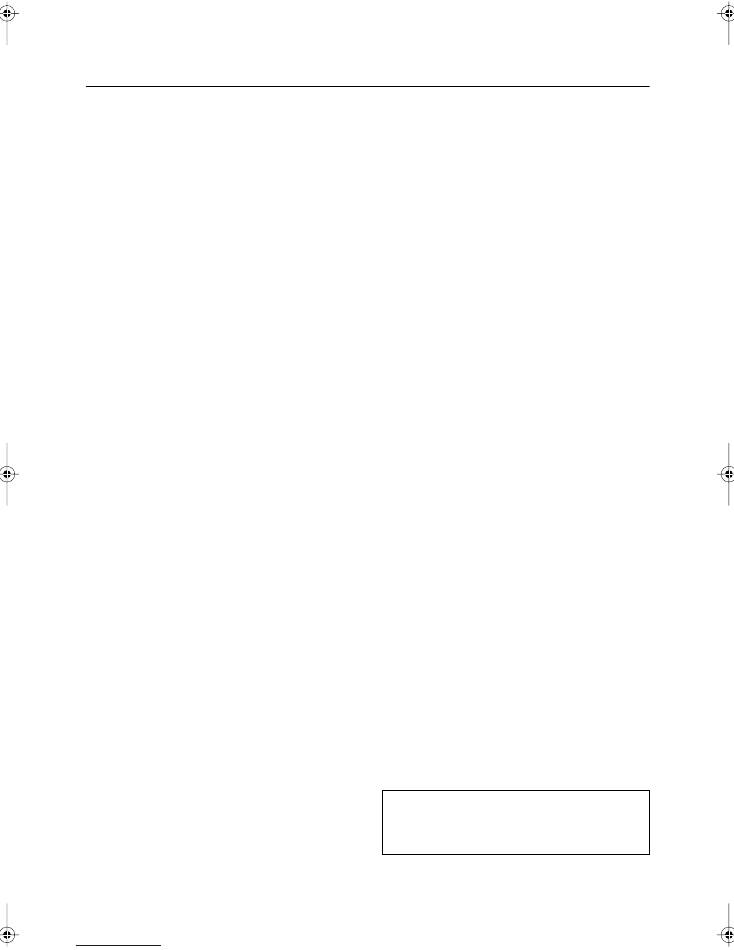
iii
Precautions
•
To assure the finest performance, please read this
manual carefully. Keep it in a safe place for future
reference.
•
Install the speakers in a cool, dry, clean place – away
from windows, sources of heat, sources of excessive
vibration, dust, moisture or cold. Avoid sources of
electrical humming (e.g., transformers and motors).
To prevent fire or electric shock, do not expose the
speakers to rain or water.
•
To prevent the enclosure from warping or discoloring,
do not expose the speakers to direct sunlight or exces-
sive humidity.
•
Avoid installing the speakers where foreign objects
may fall onto them and/or where they may be
exposed to liquid dripping or splashing.
•
Do not place the following objects on top of the
speakers:
• Other components, as they might damage or dis-
color the surface of the speakers;
• Burning objects (e.g., candles), as they might cause
fire, damage to the speakers or personal injury;
• Containers of liquid, as they might spill and cause
electric shock to the user or damage to the speak-
ers.
•
Do not place the speakers where they are liable to be
knocked over or struck by falling objects. Stable
placement will also ensure better sound.
•
Placing the speakers on the same shelf or rack as the
turntable can result in feedback.
•
Secure placement or installation is the owner’s respon-
sibility. Yamaha is not liable for accidents caused by
improper placement or installation of speakers.
•
If you note distortion, reduce the volume control on
your amplifier. Do not drive your amplifier to the
point of “clipping.” Otherwise, the speakers may be
damaged.
•
When using an amplifier with a rated output power
higher than the nominal input power of the speakers,
care should be taken not to exceed the speakers’ max-
imum input.
•
Do not clean the speakers with chemical solvents as
this might damage the finish. Use a clean, dry cloth.
•
Do not attempt to modify or fix the speakers. Contact
qualified Yamaha service personnel when service is
needed. Do not open the cabinet under any circum-
stances.
•
Please read the “Troubleshooting” section regarding
common operating errors before concluding that the
speakers are faulty.
For the SW-P240
•
Do not operate this unit upside down. It may over-
heat, possibly causing damage.
•
Do not use excessive force on switches, controls or
connection wires. When moving this unit, first dis-
connect the power plug and the wires connected to
other equipment. Never pull the wires themselves.
•
Since this unit has a built-in power amplifier, heat
radiates from the rear panel. Place the unit away from
walls, allowing at least 20 cm of space above, behind
and on both sides of the unit to prevent fire or dam-
age. Furthermore, do not position the unit with the
rear panel facing down on the floor or other surfaces.
•
When using a humidifier, be sure to avoid condensa-
tion inside this unit by allowing enough space around
the unit and avoiding excess humidification. Conden-
sation might cause fire, damage to the unit, or electric
shock.
•
Do not cover the rear panel of this unit with a news-
paper, tablecloth, curtain, etc. to avoid obstructing
heat radiation. If the temperature inside the unit rises,
it may cause fire, damage to the unit, or personal
injury.
•
Do not plug this unit into a wall outlet until all con-
nections are complete.
•
The voltage to be used must match that specified on
the rear panel. Using this unit with a voltage higher
than specified is dangerous and may cause fire, dam-
age to the unit, or personal injury. Yamaha is not
responsible for damage resulting from use of this unit
with a voltage other than specified.
•
To prevent damage from lightning, disconnect the AC
power plug during electric storms.
•
Super-bass frequencies reproduced by this unit may
cause a turntable to generate audio feedback. In this
case, move the unit away from the turntable.
•
This unit may be damaged if certain sounds are con-
tinuously output at high volume level. For example, if
20Hz–50Hz sine waves from a test disc or bass
sounds from an electronic instrument, etc. are contin-
uously output, or if a turntable stylus touches the sur-
face of a disc, reduce the volume level to prevent the
unit from being damaged.
•
If you hear distorted noise (i.e., unnatural, intermit-
tent “rapping” or “hammering” sounds) from this
unit, reduce the volume level. Extremely loud movie
soundtrack low frequency, bass-heavy sounds, or sim-
ilarly loud popular music passages can damage the
speaker system.
•
Vibration generated by super-bass frequencies may
distort images on a TV. In this case, move the unit
away from the TV set.
•
When disconnecting the power cord from the wall
outlet, grasp the plug; do not pull the cord.
•
When you plan not to use this unit for a long period
of time (i.e., vacation, etc.) disconnect the AC power
plug from the wall outlet.
•
Do not place much pressure against the subwoofer
net. It may break the net or the unit may fall, resulting
in injury.
•
Do not place anything fragile beside the subwoofer.
The air pressure produced by the subwoofer may
break the objects and cause malfunction or injury.
WARNING
TO REDUCE THE RISK OF FIRE OR ELECTRIC
SHOCK, DO NOT EXPOSE THIS UNIT TO RAIN
OR MOISTURE.
NSP240,246̲U.book Page iii Wednesday, October 22, 2003 3:29 PM

1
Table of contents
Precautions . . . . . . . . . . . . . . . . . . . . . . . . . . . . . . . . . . . . . . . . . . . iii
Introduction . . . . . . . . . . . . . . . . . . . . . . . . . . . . . . . . . . . . . . . . . . . . 2
Package contents. . . . . . . . . . . . . . . . . . . . . . . . . . . . . . . . . . . . . . . . . . . . . . . . . . . . . . . . . 2
Setting up the speakers . . . . . . . . . . . . . . . . . . . . . . . . . . . . . . . . . . . . 3
Positioning the front and surround speakers (NX-S120) . . . . . . . . . . . . . . . . . . . . . . . . . . . 3
Positioning the center speaker (NX-C120) . . . . . . . . . . . . . . . . . . . . . . . . . . . . . . . . . . . . . . 4
Positioning the subwoofer (SW-P240) . . . . . . . . . . . . . . . . . . . . . . . . . . . . . . . . . . . . . . . . 4
Mounting the front and surround speakers . . . . . . . . . . . . . . . . . . . . . . . . . . . . . . . . . . . . . 5
Connections . . . . . . . . . . . . . . . . . . . . . . . . . . . . . . . . . . . . . . . . . . . . 6
Basic connection example . . . . . . . . . . . . . . . . . . . . . . . . . . . . . . . . . . . . . . . . . . . . . . . . . . 6
Connecting speaker cables. . . . . . . . . . . . . . . . . . . . . . . . . . . . . . . . . . . . . . . . . . . . . . . . . . 7
Connecting components and the subwoofer to AC power . . . . . . . . . . . . . . . . . . . . . . . . . . 7
Using the subwoofer (SW-P240) . . . . . . . . . . . . . . . . . . . . . . . . . . . . . . 8
Pre-adjusting the subwoofer volume . . . . . . . . . . . . . . . . . . . . . . . . . . . . . . . . . . . . . . . . . . 8
Advanced Yamaha Active Servo Technology (on the SW-P240) . . . . . . . . . 9
Troubleshooting . . . . . . . . . . . . . . . . . . . . . . . . . . . . . . . . . . . . . . . . 10
Specifications . . . . . . . . . . . . . . . . . . . . . . . . . . . . . . . . . . . . . . . . . 11
Frequency characteristics . . . . . . . . . . . . . . . . . . . . . . . . . . . . . . . . . . . . . . . . . . . . . . . . . 11
NSP240,246̲U.book Page 1 Wednesday, October 22, 2003 3:29 PM
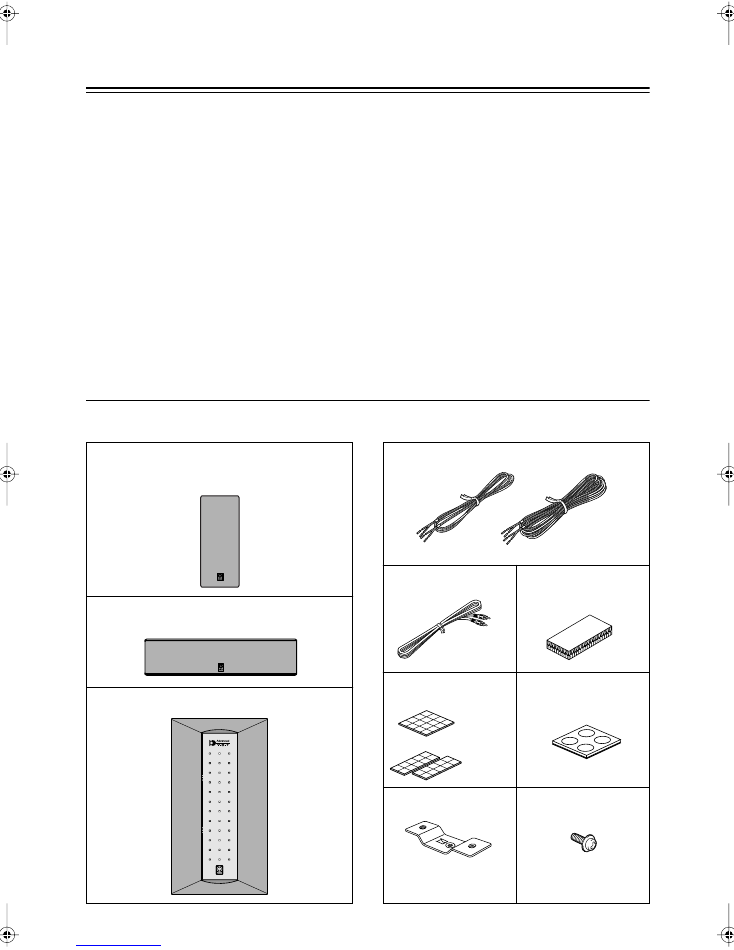
2
Introduction
Thank you for choosing a Yamaha NS-P240 or NS-P246 Home Cinema 5.1/6.1 Channel Speaker System.
Each of these systems include the following speakers:
• NX-S120
The NX-S120 are full-range acoustic-suspension speakers. Each system includes two (2) front and two
(2) surround speakers. In addition, the NS-P246 system includes an additional NX-S120 that serves as a
surround back speaker.
• NX-C120
The NX-C120 is a full-range acoustic-suspension center speaker.
• SW-P240
The SW-P240 is a subwoofer that features a built-in power amplifier. It utilizes Advanced Yamaha Active
Servo Technology to reproduce extremely high quality super-bass range sounds that add a rich, realistic
dimension to your home theater. (Refer to page 9 for detailed information on Advanced Yamaha Active
Servo Technology.)
Package contents
Please confirm that the following items are included in the package.
Front and surround speakers
(and surround back speaker in NS-P246)
Center speaker
Subwoofer
NX-S120
X 4 <NS-P240>
X 5 <NS-P246>
NX-C120
SW-P240
Speaker cables
Subwoofer cable
Fasteners
(for NX-C120)
Non-skid pads
(for NX-S120)
Non-skid pads
(for SW-P240)
X 2
[4m]
<NS-P240>
<NS-P246>
X 2 <NS-P240>
X 3 <NS-P246>
[15m]
X 3
Mounting brackets
X 4 <NS-P240>
X 5 <NS-P246>
Screws for mounting
brackets
X 4 <NS-P240>
X 5 <NS-P246>
NSP240,246̲U.book Page 2 Wednesday, October 22, 2003 3:29 PM
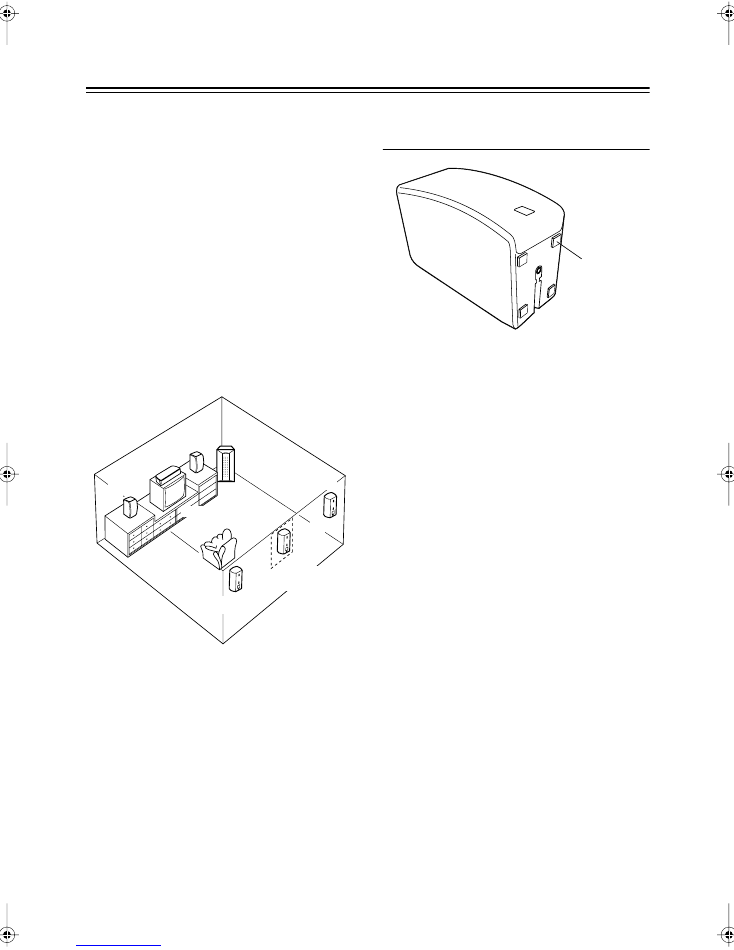
3
Setting up the speakers
Before you connect the speakers, place each
speaker in its respective location. Speaker position-
ing is very important as it affects the overall sound
quality of the system. Place the speakers in loca-
tions that will optimize the sound quality at your
listening position. Refer to the illustration below.
The position of the subwoofer is not as critical as
the position of the other speakers because low bass
tones are not highly directional. Refer to “Position-
ing the subwoofer (SW-P240)” on page 4 for more
information.
Note:
These speakers are magnetically shielded.
However, if you place them too close to a TV, they
may impair picture color. In this case, move the
speakers further away from the TV.
Positioning the front and surround
speakers (NX-S120)
Front speakers:
Place the two front speakers on
the left and right sides of the TV, at approximately
the same height as the TV, facing directly forward.
Surround speakers:
Place the left and right
surround speakers behind your listening position,
facing slightly inward, about 1.8 m (approx. 6 feet)
above the floor.
Surround back speaker (for NS-P246 sys-
tems only):
Position the surround back speaker
behind your listening position, precisely between
the surround speakers, about 1.8 m (approx. 6 feet)
above the floor.
You can set the front, surround, and surround back
speakers on tables or other supports, or mount
them on a wall or speaker stand. (For more infor-
mation, see “Mounting the front and surround
speakers” on page 5.)
Non-skid pads:
When placing the speakers on a
flat surface, attach the included non-skid pads to
the corners of the speaker bottoms, as shown
above. The non-skid pads will prevent the speakers
from sliding.
Center
Front R
Subwoofer
TV-set
Front L
Surround back
(for NS-P246)
Surround R
Surround L
Non-skid pad
NSP240,246̲U.book Page 3 Wednesday, October 22, 2003 3:29 PM

4
Positioning the center speaker
(NX-C120)
Place the center speaker precisely between the
front speakers, facing directly forward. You can
place the center speaker on top of a TV (if the top
of the TV is flat), on the floor beneath the TV, or in
an entertainment center. Be sure to place the
speaker in a stable location.
When placing the speaker on top of a TV, to pre-
vent the speaker from falling, attach the provided
fasteners at two points on the bottom of the speaker
and on top of the TV, as illustrated below.
Cautions:
•
Do not place the center speaker on a TV that has a top
surface area smaller than the speaker bottom. Other-
wise, the speaker may fall and cause injury.
•
Do not place the center speaker on a TV that has a
slanted or inclined top.
•
Do not touch the adhesive surface of a fastener after
you peel off the seal, as this will weaken the adhesive
strength of the fastener.
•
Thoroughly wipe to clean the surface where the fas-
tener is to be applied. Note that adhesive strength will
be weakened if the surface is dirty, oily or wet. Weak-
ened adhesive may cause the center speaker to fall.
Positioning the subwoofer
(SW-P240)
Although the placement of the subwoofer is not as
critical as that of the other speakers, it is best to
place the subwoofer outside either the right or left
front speaker. (See Figure
A
.)
The placement shown in Figure
B
is also accept-
able. However, in some cases, if you listen from
the center of the room, the super-bass range from
the subwoofer may sound weak. This is due to
“standing waves” that can develop between paral-
lel walls that effectively diminish or cancel the
bass sound. In this event, face the subwoofer
obliquely to the wall. It also may help to break up
the parallel surface by placing bookshelves or
other large objects along the wall.
Non-skid pads:
Place the included non-skid
pads at the four corners of the bottom of the sub-
woofer to prevent the subwoofer from sliding due
to vibration or minor impact.
Big screen
Fastener
Peel off the
seal.
A
B
: Subwoofer
: Front speaker
NSP240,246̲U.book Page 4 Wednesday, October 22, 2003 3:29 PM
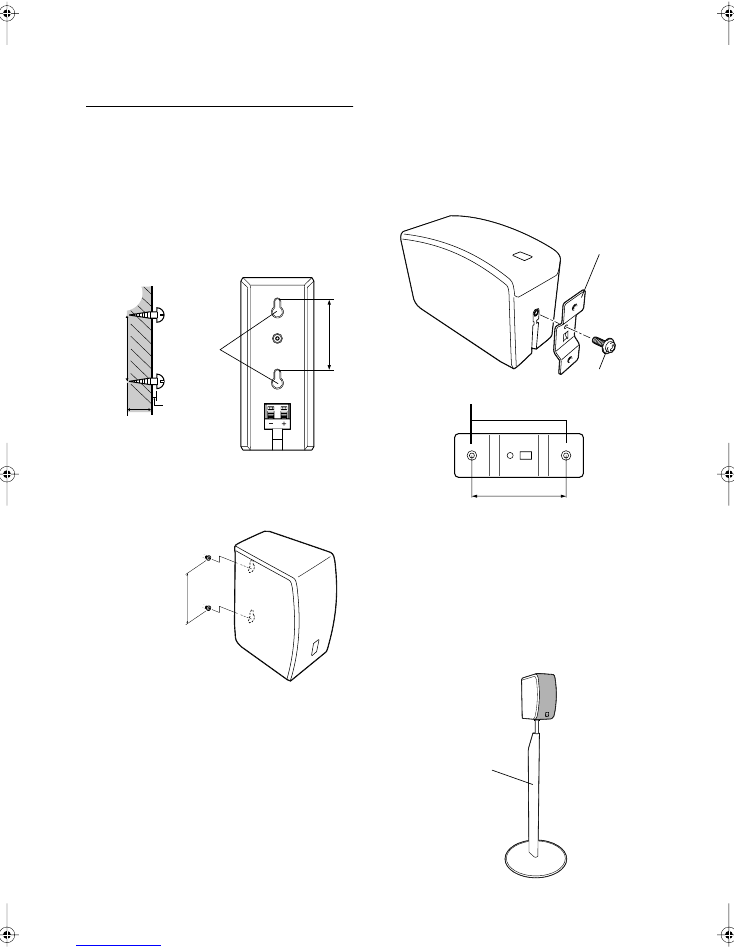
5
Mounting the front and surround
speakers
You can place the front and surround speakers (and
surround back speaker in an NS-P246 system) on a
shelf or rack, set them on the floor, or mount them
on a wall or speaker stand.
To mount the speakers on a wall:
1.
Affix screws to a firm wall or wall support as
shown below. (Use tapping screws 3.5 to 4mm
in diameter.)
2.
Suspend the speaker by mounting the holes in
the speaker’s back panels on the protruding
screws.
Cautions:
•
Each front or surround speaker weighs 0.9 kg
(2.0 lbs.). Do not mount the speakers on thin plywood
or on a wall made of soft surface material. Otherwise,
the screws may pull out of the surface and the speak-
ers may fall, possibly damaging the speakers or caus-
ing personal injury.
•
Do not affix the speakers to a wall using nails, adhe-
sives, or unstable hardware. Long term use and vibra-
tion may cause the speakers to fall.
•
To avoid accidents resulting from tripping over loose
speaker cables, affix the cables to the wall.
•
Mount the speakers in a wall location that will be
unlikely to result in injury to an individual’s head.
To attach to a bracket:
1.
Attach a bracket (part number AAX34790) to
the bottom of the speaker using a screw (part
number AAX12390) such that the convex part
of the bracket fits over the groove in the bottom
of the speaker, as shown below.
2.
Mount the speaker on the speaker stand by affix-
ing a pair of screws through the outside bracket
holes.
To mount the speakers on a speaker
stand:
You can mount the front, surround, and surround
back speakers on a speaker stand, such as the
optional Yamaha SPS-80. (For more information,
refer to the instruction manual for the SPS-80.)
Note:
The SPS-80 may be unavailable in certain
regions.
Holes
10 mm
Minimum
20 mm
70 mm
70 mm
Wall/ wall
support
Note:
Make sure that the
screws are securely affixed in
the narrow part of the holes.
70 mm
Insert only M4 screws
through the outside holes.
Mounting
bracket
(AAX34790)
Screw
(AAX12390)
60 mm
Yamaha SPS-80
speaker stand
(optional)
NSP240,246̲U.book Page 5 Wednesday, October 22, 2003 3:29 PM
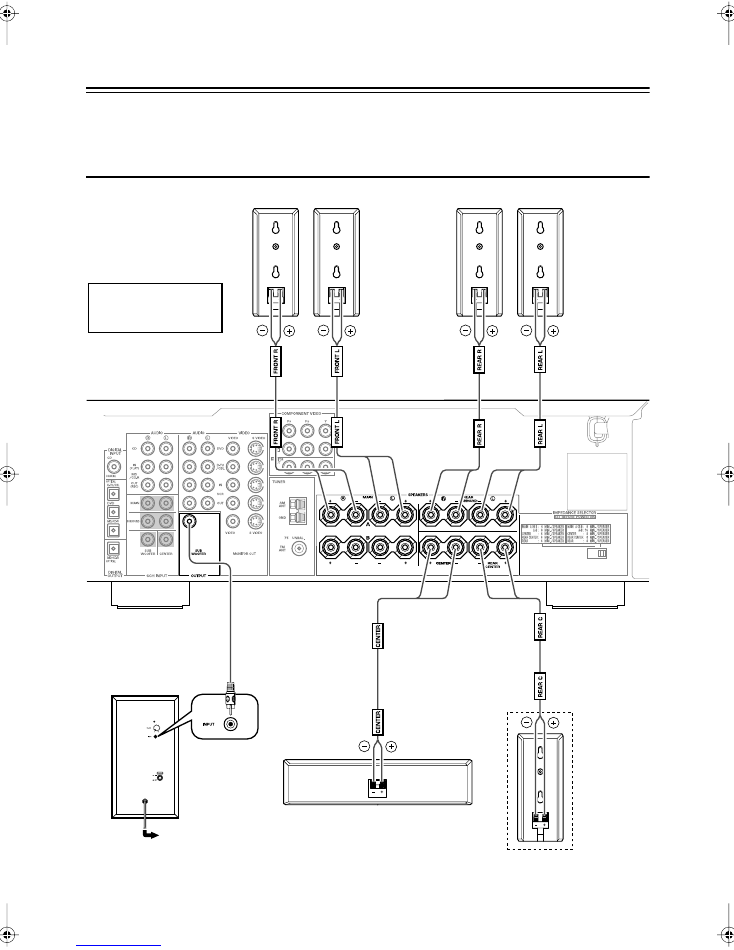
6
Connections
Caution: Plug the power cables for the subwoofer and other audio/video components into an AC out-
let only after you complete all other connections.
Basic connection example
To AC outlet
Center speaker
Surround back speaker
(in NS-P246 systems)
Subwoofer
Amplifier
Front speakers
Surround speakers
Right
Right
Left
Left
Note: The rear panel of
various amplifiers may
differ in appearance.
NSP240,246̲U.book Page 6 Wednesday, October 22, 2003 3:29 PM
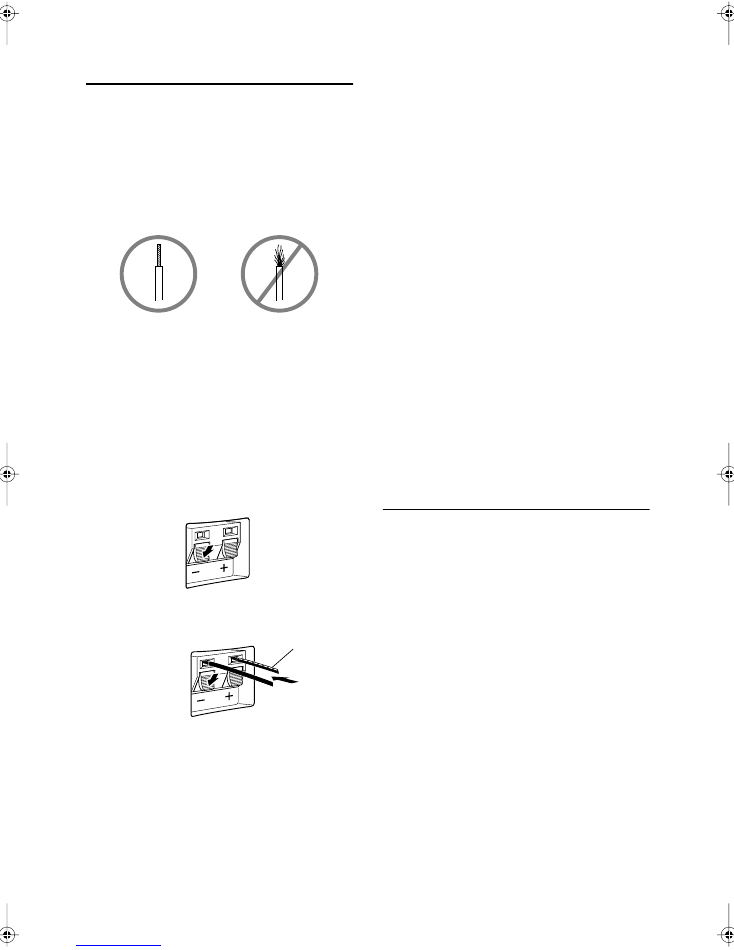
7
Connecting speaker cables
Keep the speaker cables as short as possible. Do
not bundle or roll up excess cable. If the connec-
tions are faulty, you will hear no sound from the
speakers.
Before connecting the cables:
Remove a small amount (about 10 mm) of insula-
tion coating from the end of each speaker cable.
One side of the included speaker cable is marked
with a broken white line; the other side is unlined.
Connect the (+) terminal on the speaker to the (+)
terminal on the amplifier using the cable side
marked with the broken white line. Connect the (–)
terminals on both components using the unlined
side of the speaker cable.
Inserting the cables:
1.
Press and hold the terminal tab, as shown in the
figure below.
2.
Insert the stripped wire core.
3.
Release your finger from the tab to allow it to
lock securely on the cable’s wire core.
4.
Test the security of the connection by pulling
gently on the cable at the terminal.
Note:
Do not let uninsulated speaker wires touch
each other as this could damage the speaker or the
amplifier.
Connections:
•
Connect the front, center and surround speakers (and
surround back speaker for the NS-P246) to the
speaker output terminals on your amplifier using the
included speaker cables.
– The included speaker cables have labels marked
FRONT L, FRONT R, CENTER, REAR L, REAR
R (and REAR C for NS-P246). Connect each
speaker cable to the corresponding speaker as illus-
trated in the figure on page 6.
– Connect each speaker making sure not to reverse
the polarity (+, –). If the speaker is connected with
reversed polarity, the sound will be unnatural and
lack bass.
– For the front and surround speakers only, connect
one speaker to the left (marked L) terminals on
your amplifier, and the other speaker to the right
(marked R) terminals.
•
Connect the subwoofer to the line output (pin jack)
terminal(s) on the amplifier.
– To connect to a Yamaha DSP amplifier (or AV
receiver), connect the SUBWOOFER (or LOW
PASS, etc.) terminal on the rear of the DSP ampli-
fier (or AV receiver) to the INPUT terminal on the
subwoofer.
Connecting components and the
subwoofer to AC power
After you complete all speaker and subwoofer con-
nections, plug the amplifier, other audio/video
components, and the subwoofer into an AC outlet
of appropriate voltage. Make sure the subwoofer’s
VOLUME control is set to 0 before proceeding to
adjust the speaker balance as described on page 8.
Red: positive (+)
Black: negative (–)
Red: positive (+)
Black: negative (–)
White broken line
NSP240,246̲U.book Page 7 Wednesday, October 22, 2003 3:29 PM
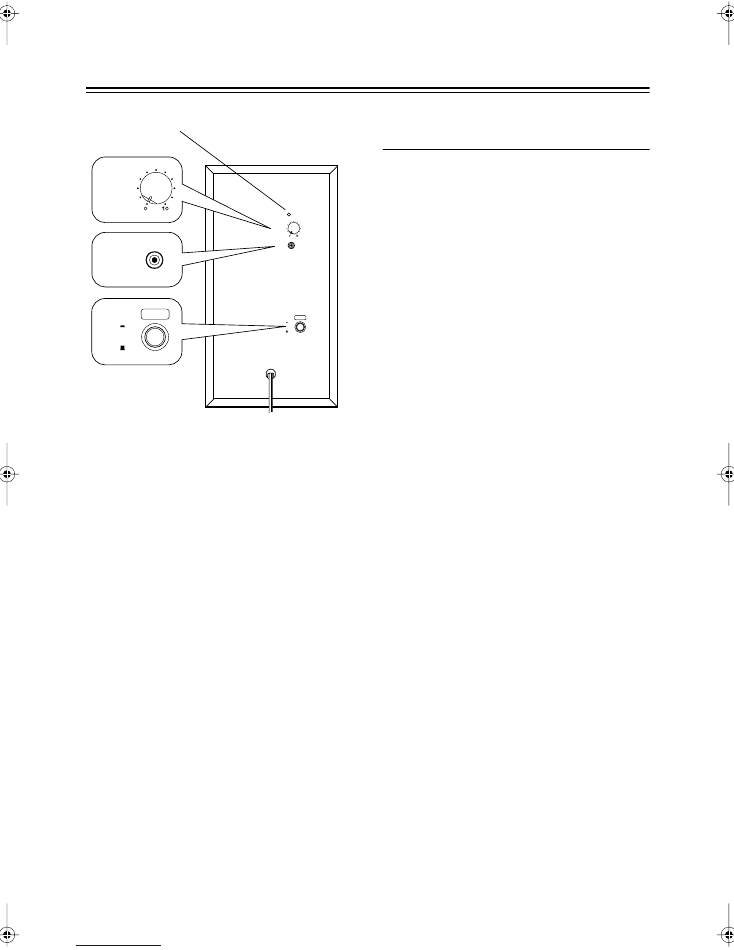
8
Using the subwoofer (SW-P240)
1
Power indicator
Lights up GREEN when the
POWER
switch
(
4
) is turned ON; turns off when the
POWER
switch is turned OFF.
2
VOLUME control
Adjusts the volume level. Turn the control
clockwise to increase the volume, and counter-
clockwise to decrease the volume.
3
INPUT terminal
Input terminal for line level signals from the
amplifier.
4
POWER switch
Press this switch to the ON position to turn on
the power to the subwoofer. When the power of
the subwoofer is on, the power indicator (
1
) on
the rear panel lights up green. Press this switch
again to set it to the OFF position to turn off the
power of the subwoofer.
Pre-adjusting the subwoofer vol-
ume
Before you use the subwoofer, first adjust the vol-
ume balance between the subwoofer and the front
speakers by following the procedure below.
1.
Set the
VOLUME
control to minimum (0).
2.
Turn on the power to all other components.
3.
Press the
POWER
switch to the ON position.
The power indicator on the rear panel lights up
green.
4.
Play a source that contains low-frequency
sounds. Adjust the amplifier’s volume control to
the desired listening level.
5.
Increase the volume gradually to adjust the vol-
ume balance between the subwoofer and the
front speakers. In most cases, set the control to a
level at which you hear slightly more bass than
when the subwoofer is not used.
6.
Adjust the volume of the entire sound system
using the amplifier’s volume control.
•
If you replace the front speakers (NX-S120) with
other speakers, you must again balance the subwoofer
and surround speaker volume.
•
For more information on adjusting the VOLUME
control, refer to “Frequency characteristics” on
page 11.
110V-120V
VOLTAGE
SELECTOR
220V-240V
OFF
POWER
ON
VOLUME
INPUT
OFF
POWER
ON
4
VOLUME
2
1
3
INPUT
Rear panel
NSP240,246̲U.book Page 8 Wednesday, October 22, 2003 3:29 PM
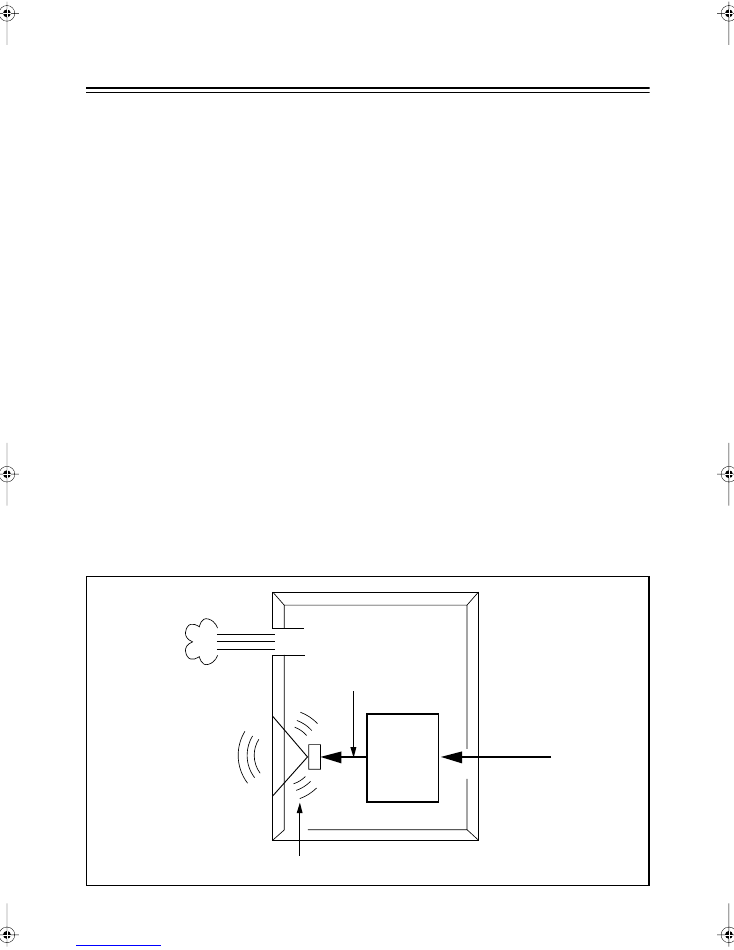
9
Advanced Yamaha Active Servo Technology (on the SW-P240)
The theory behind Yamaha Active Servo Technol-
ogy is based on two factors: the Helmholtz resona-
tor and negative-impedance drive. Active Servo
Processing speakers reproduce the bass frequen-
cies through an “air woofer,” which is a port or
opening in the speaker’s cabinet.
This opening is used instead of, and performs the
functions of, a woofer in a conventionally designed
speaker system.
Thus, signals of low amplitude within the cabinet
can, according to Helmholtz resonance theory, be
output from this opening as waves of great ampli-
tude if the size of the opening and the volume of
the cabinet are in proportion to satisfy a certain
ratio. In order to accomplish this, moreover, the
amplitudes within the cabinet must be both precise
and of sufficient power because these amplitudes
must overcome the “load” presented by the air in
the cabinet.
This problem is resolved by a design in which the
amplifier supplies special signals. If the electrical
resistance of the voice coil could be reduced to
zero, the movement of the speaker unit would
become linear with respect to signal voltage. To
accomplish this, the system utilizes a special nega-
tive-impedance output-drive amplifier that sub-
tracts the output impedance of the amplifier.
By employing negative-impedance drive circuits,
the amplifier is able to generate precise, low-ampli-
tude, low frequency waves with superior damping
characteristics.
These waves are then radiated from the cabinet
opening as high-amplitude signals. The system
can, therefore, by employing the negative-imped-
ance output drive amplifier and a speaker cabinet
featuring a Helmholtz resonator, reproduce an
extremely wide range of frequencies with out-
standing sound quality and low distortion.
The features described above combine to create the
fundamental structure of conventional Yamaha
Active Servo Technology.
Our new Active Servo Technology — Advanced
Yamaha Active Servo Technology — adopts
Advanced Negative Impedance Converter (ANIC)
circuits, which allow the conventional negative
impedance converter to dynamically vary to select
an optimum value for speaker impedance variation.
With these new ANIC circuits, Advanced Yamaha
Active Servo Technology provides a more stable
performance and improved sound pressure com-
pared to conventional Yamaha Active Servo Tech-
nology, resulting in more natural and dynamic bass
reproduction.
High-amplitude
bass sound
Cabinet
Port
Air woofer
(Helmholtz resonator)
Advanced Negative
impedance Converter
Active Servo
Processing
Amplifier
Signals of low amplitude
Signals
NSP240,246̲U.book Page 9 Wednesday, October 22, 2003 3:29 PM

10
Troubleshooting
Refer to the chart below if the unit does not function properly. If the problem you are experiencing is not
listed, or if the instructions fail to help you resolve the problem, disconnect the power cord and contact your
authorized Yamaha dealer or service center.
For the Subwoofer (SW-P240) only
Problem
Cause
What to Do
No sound.
Speaker cables are not connected
securely.
Connect the speaker cables securely.
Sound level is too low.
Speaker cables are not connected
correctly.
Connect the speaker cables correctly:
L (left) to L, R (right) to R, “+” to “+”
and “–” to “–”.
Problem
Cause
What to Do
Power is not supplied even though the
POWER switch is set to the ON position.
The power plug is not securely
connected.
Turn the power switch OFF, then
connect the power plug securely.
No sound.
The VOLUME control is set to 0.
Turn the VOLUME control to the
right (clockwise).
Speaker cables are not connected
securely.
Connect the speaker cables securely.
Sound level is too low.
Speaker cables are not connected
correctly.
Connect the speaker cables correctly:
L (left) to L, R (right) to R, “+” to “+”
and “–” to “–”.
You are playing a sound source that
includes inadequate bass frequencies.
Play a sound source that includes
more bass frequencies.
The sound level has been diminished
by standing waves.
Reposition the subwoofer, or break
up the parallel wall surface by
placing bookshelves or other large
objects along the wall.
NSP240,246̲U.book Page 10 Wednesday, October 22, 2003 3:29 PM
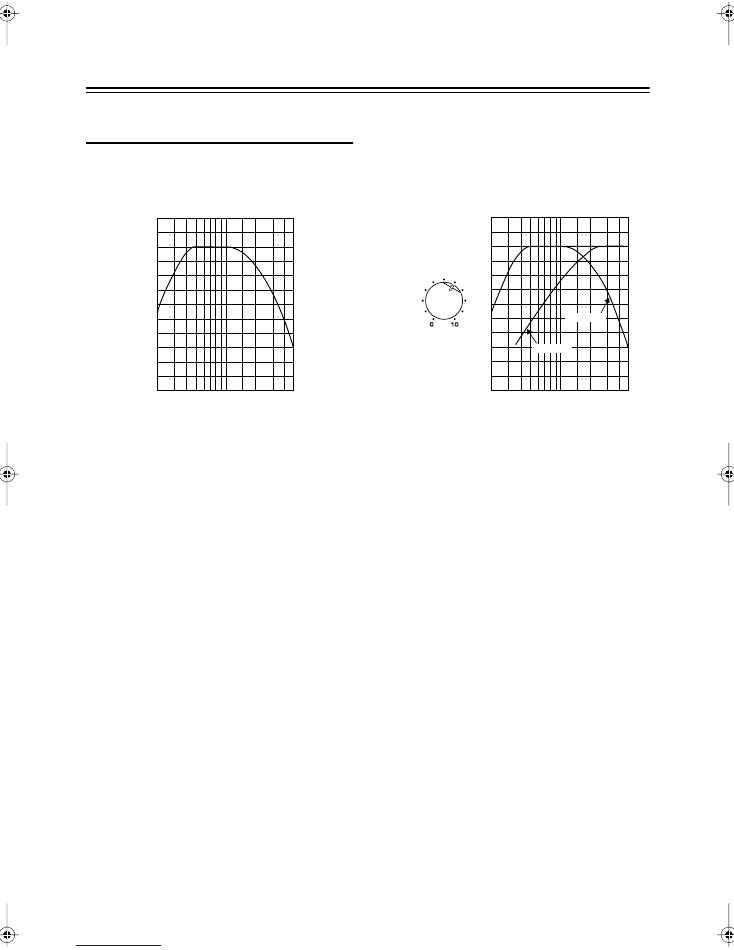
11
Specifications
Frequency characteristics
The following graph displays the frequency char-
acteristics of the SW-P240 subwoofer.
The following graph displays the frequency char-
acteristics of the SW-P240 subwoofer combined
with NX-S120 speakers.
NX-S120/NX-C120
Type
........Full-range acoustic-suspension speaker
system
Magnetically shielded type
Driver
............5 cm (2") full-range cone speaker x 2
Nominal Input Power
..................................... 30 W
Maximum Input Power
................................. 100 W
Impedance
.........................................................6
Ω
Frequency Response
... 100 Hz – 25 kHz (–10 dB)
Sensitivity
...................................... 86 dB/2.83 Vm
Dimensions (W x H x D)
<NX-S120> ............. 72 mm x 170 mm x 108 mm
(2-15/16" x 6-11/16" x 4-1/4")
<NX-C120> ..............300 mm x 72 mm x 105 mm
(11-13/16" x 2-15/16" x 4-1/8")
Weight
<NX-S120> .....................................0.9 kg (2 lbs.)
<NX-C120> ............................1.1 kg (2 lbs. 7 oz.)
SW-P240
Type
....... Advanced Yamaha Active Servo Tech-
nology
Magnetically shielded type
Driver
.............................. 16 cm (6.5") cone woofer
Output Power
......... 50 W (100 Hz, 5
Ω
at THD=10%)
Dynamic Power
......................................... 100 W, 5
Ω
Input Impedance
......INPUT (1P RCA pin jack): 12 k
Ω
Input Sensitivity
............ INPUT (1P RCA pin jack):
30 mV (100 Hz, 5
Ω
at 50 W)
Power Supply
............................... AC 120 V, 60 Hz
Dimensions (W x H x D)
...............................200 mm x 365 mm x 390 mm
(7-7/8" x 14-3/8" x 15-3/8")
Weight
.....................................8.4 kg (18 lbs. 8 oz.)
Specifications are subject to change without notice.
20
50
100
200
500 Hz
40
50
60
70
80
90
100 dB
20
50
100
200
500 Hz
40
50
60
70
80
90
100 dB
SW-P240
NX-S120
VOLUME
NSP240,246̲U.book Page 11 Wednesday, October 22, 2003 3:29 PM

2003
All rights reserved.
YAMAHA ELECTRONICS CORPORATION, USA
6660 ORANGETHORPE AVE., BUENA PARK, CALIF. 90620, U.S.A.
YAMAHA CANADA MUSIC LTD.
135 MILNER AVE., SCARBOROUGH, ONTARIO M1S 3R1, CANADA
YAMAHA ELECTRONIK EUROPA G.m.b.H.
SIEMENSSTR. 22-34, 25462 RELLINGEN BEI HAMBURG, F.R. OF GERMANY
YAMAHA ELECTRONIQUE FRANCE S.A.
RUE AMBROISE CROIZAT BP70 CROISSY-BEAUBOURG 77312 MARNE-LA-VALLEE CEDEX02, FRANCE
YAMAHA ELECTRONICS (UK) LTD.
YAMAHA HOUSE, 200 RICKMANSWORTH ROAD WATFORD, HERTS WD18 7GQ, ENGLAND
YAMAHA SCANDINAVIA A.B.
J A WETTERGRENS GATA 1, BOX 30053, 400 43 VÄSTRA FRÖLUNDA, SWEDEN
YAMAHA MUSIC AUSTRALIA PTY, LTD.
17-33 MARKET ST., SOUTH MELBOURNE, 3205 VIC., AUSTRALIA
Printed in China
WC87650
©
IP
NSP240,246̲U.book Page 12 Wednesday, October 22, 2003 3:29 PM